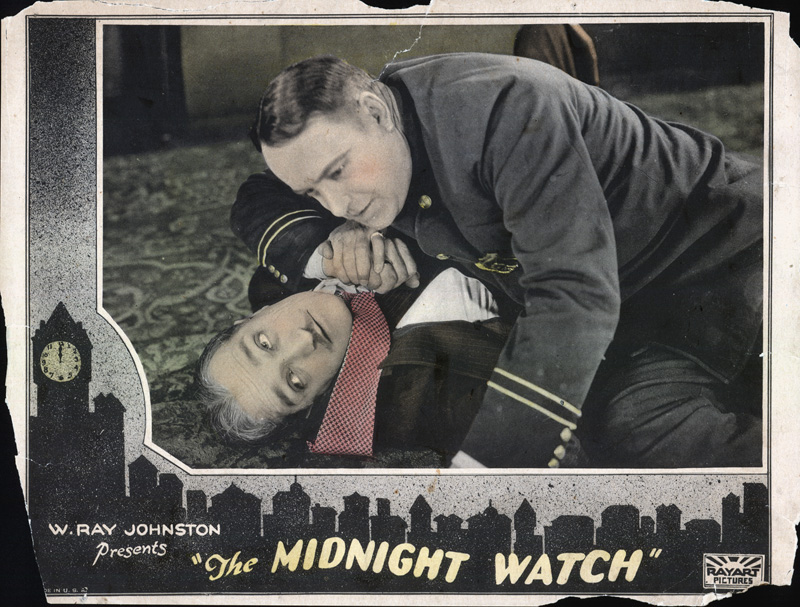|
|
Bob Steele & Blanche Mehaffey in Sunrise Trail
A Trem Carr Production | Placerita Canyon

Click image to enlarge Production still showing Blanche Mehaffey and Bob Steele in "Sunrise Trail" (Trem Carr Productions, 1931). It was the first talking picture for the silent vixen Mehaffey. Producer Trem Carr and Second Unit Director Paul Malvern of Monogram Pictures had already been shooting in Placerita Canyon for several years before 1931, when Carr took out a five-year lease on a movie ranch east of present-day Highway 14 — where Disney's Golden Oak Ranch now sits. (In 1936, Carr balked at a rent hike, so Carr and pal Ernie Hickson trucked their Western movie town down the road to property Hickson purchased at the site of present-day Melody Ranch.) "Sunrise Trail" was directed by J.P. McCarthy; shot by Carr's favored cinematographer Archie Stout; and as usual, Hickson handled the set decoration. Tiffany Productions distributed the film, which follows the typical Carr/Malvern rubric: Steele is a good guy masquerading as a bad guy so he can infiltrate a gang and bring its members to justice. It deviates only insofar as the hero's love interest (Mehaffey) is a barmaid rather than a rancher's daughter. About Bob Steele: About Bob Steele. Bob Steele was a big name in small Poverty Row pictures of the 1930s and '40s, landing lead roles in dozens of B-Westerns from the likes of Monogram and Republic. Born Robert Adrian Bradbury in Portland, Ore., on Jan. 23, 1907, Bob and his twin brother, Bill, toured with their vaudevillian parents as children. Their father, Robert N. Bradbury, came to Hollywood in the late 1910s and transitioned into film, first as an actor and then as a director. In 1920, the elder Bradbury first put his sons on the screen in "The Adventures of Bob and Bill," which was shot in Glendale, where the family lived. More often, Robert N. Bradbury shot in Placerita Canyon, which was dotted with movie ranches by the early 1920s. Bob Junior got his break in 1927 when, under contract with FBO, he landed the title role in "The Mojave Kid," directed by his father. Bob changed his name to Bob Steele for that film and stuck with it. Perhaps Steele's biggest contribution to the screen came vicariously in 1933 when he convinced his dad to cast one of his Glendale High School classmates, a budding actor named Marion Morrison, as the hero lawman in a series of films produced by Monogram's Paul Malvern under the "Lone Star Productions" label. Like Steele, his friend also changed his name — to John Wayne. Steele reached the height of his popularity during the 1930s with characters that drew on his physicality. His stardom diminished as he aged, but he didn't slow down. The 1940s saw Steele and some of his contemporaries like Johnny Mack Brown and Hoot Gibson churn out numerous B-Westerns for Monogram, frequently appearing together in pictures shot at Ernie Hickson's Monogram Ranch in Placerita Canyon. During the 1950s and beyond, Steele's old high school chum returned the favor that had been done two decades earlier. Steele landed bit parts in major John Wayne pictures including "Island in the Sky," "Rio Bravo" and "Rio Lobo." Steele made guest appearances in all of the popular television Westerns of the 1950s and '60s. He had a recurring role as Trooper Duffy in the 1965-67 comedic series, "F Troop," and closed out his film career in the early 1970s. He died at a hospital in Burbank on Dec. 21, 1988, following a long battle with emphysema. About Blanche Mehaffey: Blanche Mehaffey was born in Cincinnati on July 28 in either 1907 or more likely 1908. Her mother, Blanche Berndt, was a soprano singer, and Blanche was a very young Ziegfeld Follies dancer before coming to Hollywood and landing her first film role in the 1923 Hal Roach picture, "Fully Insured." Mehaffey appeared in several Hal Roach silent comedies during the 1920s. Hollywood had fully embraced sound by 1929, so she went to New York and studied voice for more than a year. She returned in 1931 to appear opposite Bob Steele in her first talking picture, "Sunrise Trail," a Trem Carr Western shot in Placerita Canyon. Mehaffey was briefly married to oilman George Joseph Hausen and to film producer Ralph M. Like. She retired from the screen in 1938 and died in Los Angeles 30 years later, on March 31, 1968. Her grave marker at Forest Lawn-Glendale reads "Blanche M. Collins." Further Reading: Melody Ranch: Movie Magic in Placerita Canyon |
SEE ALSO:
1928
Code of the West
(Newhall 1929)
1932
1934
Embossed Envelope 1932
Trem Carr, W. Ray Johnston 1934 ("Lost in the Stratosphere")
The Midnight Watch 1927
Ridin' Luck 1927
Prince of the Plains 1927
Gun-Hand Garrison 1927
Isle of Lost Men 1928
Code of the West 1929
Shanghai Rose 1929
Near the Rainbow's End 1930
God's Country and The Man 1931
Sunrise Trail 1931
South of Santa Fe 1932
The Return of Casey Jones 1932
Happy Landing 1934
Non-SCV 1930
Full Movie
|
The site owner makes no assertions as to ownership of any original copyrights to digitized images. However, these images are intended for Personal or Research use only. Any other kind of use, including but not limited to commercial or scholarly publication in any medium or format, public exhibition, or use online or in a web site, may be subject to additional restrictions including but not limited to the copyrights held by parties other than the site owner. USERS ARE SOLELY RESPONSIBLE for determining the existence of such rights and for obtaining any permissions and/or paying associated fees necessary for the proposed use.




















